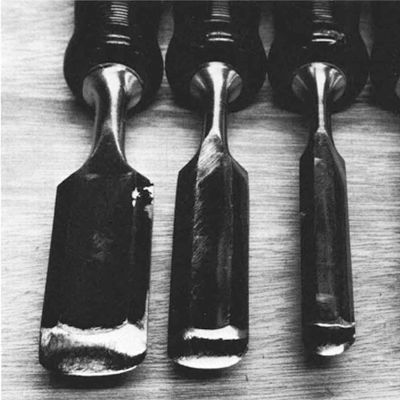
Synopsis: Eric Schramm has developed a few time-savers over the years. He re-ground butt chisels to make a set of four round-nose chisels, which he uses in place of many gouges with different sweeps and widths. In this quick article, he talks about how he carves with them; how he maintains a razor-sharp edge on his carving tools, chisels, and plane irons; and how he devised a pinwheel sander for sanding sculpted furniture. He made it from worn stroke-sander belts that he got for free from a local cabinet shop.
One of the most valuable additions to my collection of carving tools is a set of four round-nose chisels. Originally they were ordinary butt chisels, but I re-ground them to rounded profiles and hollow-ground the bevels to a length of about 3/8-in., as the factoryground bevel was too steep for carving. I use these four chisels in place of many gouges having different sweeps and widths. Used with the bevel down, the 1-in. and 3/4-in. chisels are excellent tools for wasting wood fast in relief carvings as well as roughing-in a carving in-the-round. Used with the bevel up, all four chisels work well for shaping and smoothing convex surfaces. The 1/2-in. and 1/4-in. chisels eliminate the need for a large number of gouges when setting-in a line. For example, setting-in a simple scroll can take up to eight different numbered gouges, as shown. But this scroll can be set-in using only one or two round-nose chisels.
To maintain a razor-sharp edge on my carving tools, chisels and plane irons, I made a rotary hone from a disc of 1/4-in. plywood covered with 3/16-in. thick leather which is cemented in place. I bored a hole in the center of the disc and mounted it on a work arbor (available from Sears or a well-stocked hardware store); with the arbor chucked in my drill press and the leather stropping surface charged with white rouge (available from Sears), I can hone chisels and gouges quickly, without having to interrupt my work by getting out and setting up a lot of sharpening equipment. The drill press should run at its lowest RPM. You can also use tripoli or jeweler’s rouge, but neither is as effective as white rouge.
For sanding sculptured furniture parts, I devised a pinwheel sander, which I make up from worn stroke sander belts that I get free from a local cabinet shop. I cut the belt into 8-in. dia. circles and cut a 1/2-in. hole in the center of each. Then, using a paper pattern and scissors, I cut eight evenly spaced slits from the outside toward the center. These stop about 1 1/2-in. from the center hole. Next I fold one corner of each slit over the center and secure the pinwheel on a work arbor, whose collars hold the folded ends in place. A little piece of double-sided tape on the folded corner will keep the pinwheel together until it’s secured on the arbor. Take care that all the folds go in the right direction in relation to rotation.
From Fine Woodworking #30
For the full article, download the PDF below:
Fine Woodworking Recommended Products

Norton Water Stones

Veritas Precision Square

Suizan Japanese Pull Saw




















Log in or create an account to post a comment.
Sign up Log in